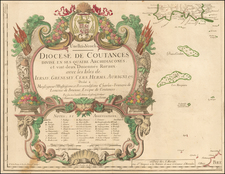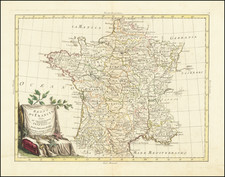Detailed engraved antique map of Ancient France during the time of the Romans, divided into regions.
The map represents ancient France, known as Gaul, during the Roman era. The major regional divisions mentioned — Celtica Lugdunensis, Aquitanica, Narbonensis, and Belgica — correspond to Roman provincial divisions. Belgica, stretching north to Batavia along the Rhine River and southeast to the Helvetii tribes and the Adula Mountains, indicates a detailed Roman administrative and military grasp of the region.
Roman Gaul, denoting the region under Roman control from the 1st century BC to the 5th century AD, traces its beginnings to interactions with the Roman Republic. By the mid-2nd century BC, Romans were trading heavily with Massilia (modern Marseille) and had established an alliance to protect against local Gauls and Carthaginians. Roman influence and subsequent conquests, particularly by Julius Caesar during the Gallic Wars (58-50 BC), led to the annexation of most of Gaul.
Post-conquest, while not immediately formalized as Roman provinces, Gaul saw a series of rebellions and maintained a Roman military presence to quell unrest. Formal provincial organization occurred under Emperor Augustus in 27 BC, dividing Gaul into the provinces of Gallia Aquitania, Gallia Belgica, and Gallia Lugdunensis. Parts of eastern Gaul were later incorporated into Raetia and Germania Superior.
Roman citizenship was extended to all free inhabitants of the Roman Empire, including Gaul, under the Constitutio Antoniniana in 212 AD, symbolizing the complete integration of Gaul into the Roman state.
Jan Janssonius (also known as Johann or Jan Jansson or Janszoon) (1588-1664) was a renowned geographer and publisher of the seventeenth century, when the Dutch dominated map publishing in Europe. Born in Arnhem, Jan was first exposed to the trade via his father, who was also a bookseller and publisher. In 1612, Jan married the daughter of Jodocus Hondius, who was also a prominent mapmaker and seller. Jonssonius’ first maps date from 1616.
In the 1630s, Janssonius worked with his brother-in-law, Henricus Hondius. Their most successful venture was to reissue the Mercator-Hondius atlas. Jodocus Hondius had acquired the plates to the Mercator atlas, first published in 1595, and added 36 additional maps. After Hondius died in 1612, Henricus took over publication; Janssonius joined the venture in 1633. Eventually, the atlas was renamed the Atlas Novus and then the Atlas Major, by which time it had expanded to eleven volumes. Janssonius is also well known for his volume of English county maps, published in 1646.
Janssonius died in Amsterdam in 1664. His son-in-law, Johannes van Waesbergen, took over his business. Eventually, many of Janssonius’ plates were sold to Gerard Valck and Pieter Schenk, who added their names and continued to reissue the maps.










![[Grenoble 1968 Winter Olympics] L'Alpe D'Huez France - Isere](https://storage.googleapis.com/raremaps/img/small/84340.jpg)
![[Portrait of Louis XV as a child] Ludovicus XV. Franciae et Navarrae Rex Natus 15 Febr. Anno 1710.](https://storage.googleapis.com/raremaps/img/small/95867.jpg)
![Generale Caert van Vranckryck [General Map of France]](https://storage.googleapis.com/raremaps/img/small/93273.jpg)

![(Geological Map of France) Carte Geologique de la France [4 sheets]](https://storage.googleapis.com/raremaps/img/small/93799.jpg)